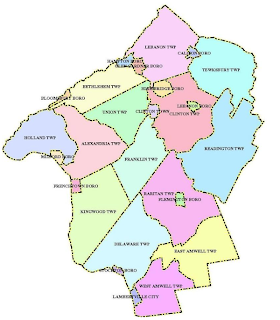From the Hunterdon County Democrat.
Love seeing stories from East Amwell, which has often been covered for its expansive open space preservation efforts.
EAST AMWELL TWP. — Overlooking the vast expanse of grasslands that
slopes toward the forested Sourland Ridge, more than a dozen advocates
of open space held a celebration Nov. 2 to applaud the acquisition of
the 89-acre parcel on Cider Mill Road.
In a cooperative partnership, the Delaware & Raritan Greenway
Land Trust cobbled together money for the $2,056,110 acquisition from
state funds and nonprofit groups: $400,000 from state land acquisition
funds, $400,000 from East Amwell’s Green Acres grant, $200,000 from the
Natural Resource Damages Fund to match half of the township’s
contribution, $407,882 from the county’s nonprofit grant program,
$411,222 from Conservation Resources Inc., and $237,006 from a Green
Acres nonprofit grant.
Since some of the money pledged was unavailable for the December 2010
closing, a low-interest loan from the Open Space Institute enabled the
land trust to meet the purchase price by the deadline. Earlier this
year, the other partners helped pay back the loan.
The township shares ownership of the property with the land trust and
the state Division of Fish and Wildlife. Mayor Larry Tatsch said it is
the first grasslands habitat that the township has been able to preserve
for public use.
Sean Grace, an East Amwell resident and sanctuary director of the New
Jersey Audubon Society, said grasslands are one of the least preserved
habitats in North America, noting that less than 1 percent of the
original grasslands remains.
“They’re critically endangered habitats and all animals that are then associated with it,” he said.
Among the birds that will frequent the Cider Mill preserve are
American kestrels, bobolinks, Eastern meadowlarks, Northern harriers,
short-eared owls, grasshopper sparrows and indigo buntings, many of
which are listed as endangered, threatened or as a species of special
concern.
As a result of changes in farming practices, providing and managing a
place for grassland birds is an uphill battle in New Jersey, said Tony
Petrongolo, Bureau of Land Management chief for the state Division of
Fish and Wildlife.
“Where most of the landscape used to provide a habitat before, today every 90 acres like this is a struggle,” he said.
Michael Catania, president of Conservation Resources Inc., called the preservation of the property a substantial victory.
“One hundred years from now, people are going to look back and say,
‘Thank God, somebody had the foresight to preserve this because this
doesn’t look like other parts of our state,’” he said.
In addition to protecting a critical habitat, Linda Mead, president
and CEO of the land trust, said the public can walk along the property,
taking in the scenic views, stars and grassland birds.
“It’s a perfect example of what the statewide Green Acres program sets out to do,” she said.
Diana Raichel, a conservation biologist for the land trust, will help
manage the property. Key to effort is the need to delay mowing until
after the birds have nested and fledged, and to keep woody vegetation at
bay, she said.
“Anything that breaks up a field is less suitable for these
area-sensitive birds,” she said, adding that grassland birds require
large open spaces. “You want to maintain this ecological state to keep
it from succeeding into a forest.”
Subscribe to:
Post Comments (Atom)

No comments:
Post a Comment